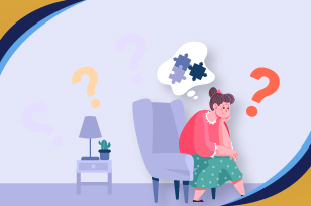Personality is a way of thinking, behaving, feeling, and reacting in different circumstances that makes a person distinct from other people. It is a recognition of a man which refers to an individual’s pattern of manners, and characteristics that are long-lasting and existing since youth or early childhood. Features of personality include the way individuals think about themselves, such as self-confidence or a lack thereof. How do they relate to people if they are shy or friendly? How they react emotionally to any happening.
Have you ever felt you are riding an emotional rollercoaster, or perhaps, noticed a consistent pattern in how someone interacts with the world that just seems… different? We all have our ups and downs in mood. One day, you feel like you are on top of the world, and the next moment, you feel a little blue. But when these feelings heightened, they turned into a disorder. These are called mood disorders.
It is important to find differences between personality disorders and mood disorders. These two are often confused and misunderstood terms. While both traits influence how we think, feel, and behave, they have different causes and remain there in different ways.
It is easy to get confused when discussing mental health, especially when terms like “mood disorder” and personality disorder” are thrown around.
While both traits bring in significant distress and impairment, they represent different challenges.
What Are Mood Disorders?
These are more like the shifting sands of emotion.
Emotions are like your weather. Sometimes it is sunny, and sometimes rainy, and a storm rolls in. But for most of us, these weather patterns shift, and we adapt to them. With a mood disorder, however, the “weather” becomes extreme, prolonged, and greatly interrupts daily life.
A mood disorder exaggerates these waves and makes them more intense and long-lasting.
At their core, mood disorders are about instabilities in an individual’s emotional condition.
These are characterized by significant changes in mood, either extreme highs (mania or hypomania) or extreme lows (depression) or sometimes a combination of both.
We can better explain in this sense like someone with a mood disorder might experience a period of intense sadness that lasts for weeks, which makes it difficult to function in their daily lives. On the other hand, they have periods of excessive energy and impulsivity that are out of their control. Some common examples of mood disorders include:
Read More:
You can better understand this way:
Episodic Nature
Mood disorders often come in episodes. A person might experience a period of intense depression, which is followed by a return to their typical baseline and even a swing into a manic episode. These episodes have a beginning, middle, and end, but their time varies from person to person.
Impact On Functioning
During an episode, the person’s ability to work, maintain relationships, and engage in self-care can be severely compromised.
Biological Reinforcement
While life circumstances play a role, there is important medical evidence that points to neurobiological factors, including imbalances in neurotransmitters (serotonin, dopamine, and norepinephrine).
Read More: What’s The Difference Between A Mood Disorder And A Personality Disorder?
The Most Common Mood Disorders
Major depressive disorder (MDD)
Major Depressive Disorder is categorized by loss of interest and pleasure, persistent sadness, and changes in a person’s habit of eating or sleeping. Moreover, it also brings in uneven sleep forms, fatigue, feelings of being unvalued, and difficulty focusing.
Bipolar Disorder
Bipolar Disorder brings a dramatic shift in mood, energy, and activity levels of a person. There are areas of high or short-tempered mood and depression (mania or hypomania). Bipolar I disorder includes at least one manic episode, while bipolar II disorder contains hypomanic and major depressive episodes, or sometimes schizophrenia.
Persistent Depressive Disorder
This is a more chronic and less simple kind of depression that lasts for at least two years.
These disorders are often episodic, which means they come and go. When a person does not feel any episodic mood change, it is relatively stable.

What are Personality Disorders?
Now, divert your focus from the weather to someone’s real way of seeing the world.
Personality, in an overall sense, is what makes you truly “you”. It’s a unique way of how you feel, think, and interact with the world. It’s your recognition that involves ingrained, inflexible patterns of thinking and behaving that deviate significantly from cultural expectations.
These patterns are pervasive and enduring, and disturb many facets of a person’s life, including relationships and work.
Unlike mood disorders, which come and go, personality disorders are typically present from adolescence or childhood and are an identification of who the person is. This is a behavior that deviates from cultural expectations.
Read More: Child Psychiatrist – A Guide For Parents & Guardians
Some examples include:
Pervasive And Enduring
Unlike episodic mood swings, personality disorders represent a persistent, lifelong style of a person. These styles are evident from early childhood and remain stable over time.
Impact on relationship and Self-identity
The major difficulty lies in how individuals think about themselves, others, and the world, leading to major challenges in interpersonal relationships.
Developmental trajectory
While we can’t label them as merely biological, personality developmental factors are early childhood experiences and genetic predispositions. The “Diagnostic and Statistical Manual of Mental Disorders, Fifth Edition (DSM-5) explains ten different personality disorders, which are then grouped into three clusters where each echoes different core patterns of behavior.
Read More: How to Help Someone With Bipolar Disorder?
Three Clusters Of Personality Disorders
Cluster A (Odd or Eccentric)
- Paranoid personality disorder: It illustrates behaviors of inescapable distrust and doubts about others.
- Schizoid personality disorder has key characteristics of a disinterest in social relationships and a limited range of emotional expression.
- Schizotypal personality disorder: these personalities feel acute discomfort in close relationships, mental or perceptual distortions, and peculiarities of behavior.
Cluster B (Dramatic, Emotional, or Erratic)
- Antisocial personality disorder: Persons with such a personality trait disregard and violate the rights of others, are often involved in deceit, impulsiveness, and a lack of empathy.
- Borderline Personality Disorder (BPD): Here, people have instability in relationships, self-image, and marked impulsivity (acting without thinking). Dr. Marsha Linehan’s work in Dialectical Behavior Therapy (DBT) for BPD pinpoints profound emotional dysregulation, which emphasizes its pervasive nature. However, there is a difference between borderline personality disorder vs bipolar mood swings.
- Histrionic Personality Disorder: This is excessive emotionality and attention-seeking behavior.
- Narcissistic personality disorder: The characteristics include boasting, admiration, and a lack of empathy towards others.
Cluster C (Anxious or Fearful)
- Avoidant personality disorder: It brings in social inhibition, feelings of insufficiency, and hypersensitivity to negative assessment.
- Dependent Personality Disorder: A person shows a natural and excessive need to be taken care of. This leads to submissive and clinging behavior and fears of separation.
- Obsessive-Compulsive Personality Disorder (OCPD): These personality traits include preoccupation with orderliness, where people focus on order, perfectionism, and control of things or relations in daily life.
(Note) This is unlike obsessive-compulsive disorder, an anxiety and mental disorder.
These disorders can make it difficult for people to keep healthy relationships and drive social situations.
Read More: Do You Ever Wonder That Your OCD Thoughts Are Not Real?
Major Key Differences to Remember
Let’s look at the decisive core differences to make this crystal clear:
| Feature | Mood Disorders | Personality Disorders |
|---|---|---|
| Nature | Episodic disorders in emotional state. | Pervasive, regular forms of thought, behavior, and feelings. |
| Onset | It can occur at any age, often with clear stimuli or biological predispositions. | Generally, apparent by early adulthood and stable over time. |
| Focus | What someone is feeling (e.g., intense sadness, euphoria). | How someone always relates to themselves and the world. |
| Changeability | More amenable to symptom-focused treatment, often with significant periods of remission. | More challenging to treat, while focusing on long-term pattern change. |
| Sense of Self | is usually intact, though it changes during episodes. | Often unstable or fragmented, which can lead to identity issues. |
| Primary Impairment | Fluctuations in emotional state and associated functional decline. | Chronic difficulties in relationships, self-perception, and impulse control. |

Why Does This Distinction Matter?
The acknowledgment of the difference between mood disorder and personality disorder is not just academic; it directly influences treatment and understanding.
Tailored Treatment
A mood disorder might respond well to medication that targets neurotransmitter imbalances, which is combined with therapy and focuses on managing depressive or manic episodes. For personality disorder, medicine might be used to manage co-occurring symptoms (anxiety and depression), but the primary treatment is often long-term psychotherapy to reshape the rooted patterns of thinking and behaving. For instance, dialectical behavior therapy (DBT) and cognitive-behavioral therapy (CBT) are highly effective for typical personality disorders. While other major forms of psychotherapy include CBT, interpersonal therapy (IPT) is the foundation of mood disorder treatment.
Empathy and Understanding
When someone is struggling with a mood disorder, resulting from mental disorders, we often understand it as a temporary illness that will pass. While personality disorders are sometimes misunderstood as intentional malice or stubbornness. When one accepts these traits as a deeply ingrained pattern, it helps foster empathy and encourages professional treatment.
Prognosis And Expectations
While both make people weak, the expected course and challenges in recovery differ. Mood disorders often have periods of remission, while personality disorders require a more sustained and committed effort to shift. This is not to say that one is “worse” than the other, but the method of healing is different.
Read More: Understanding ADHD Mood Swings: A Journey Through Emotional Waves
Treatment Beyond the Diagnosis
Many individuals experience both mood and personality disorders at the same time. This is a co-occurrence and is common, which complicates diagnosis and treatment. The recognition needs a comprehensive treatment from qualified mental health professionals. If you or someone is struggling with mood or personality disorders or both, the most valuable step is to reach out.
The mental health professionals can provide an accurate assessment and can offer a tailored treatment plan. They can guide you towards greater stability and well-being. This is not about fixing a broken part, rather, it is about nurturing growth, understanding, and ultimately building a life that feels more authentic and fulfilling.
We at Orange Coast Psychiatry can foster a world where everyone has the opportunity to thrive, regardless of the challenges they face in their daily life. Book an appointment here by calling us and live a better life.


















